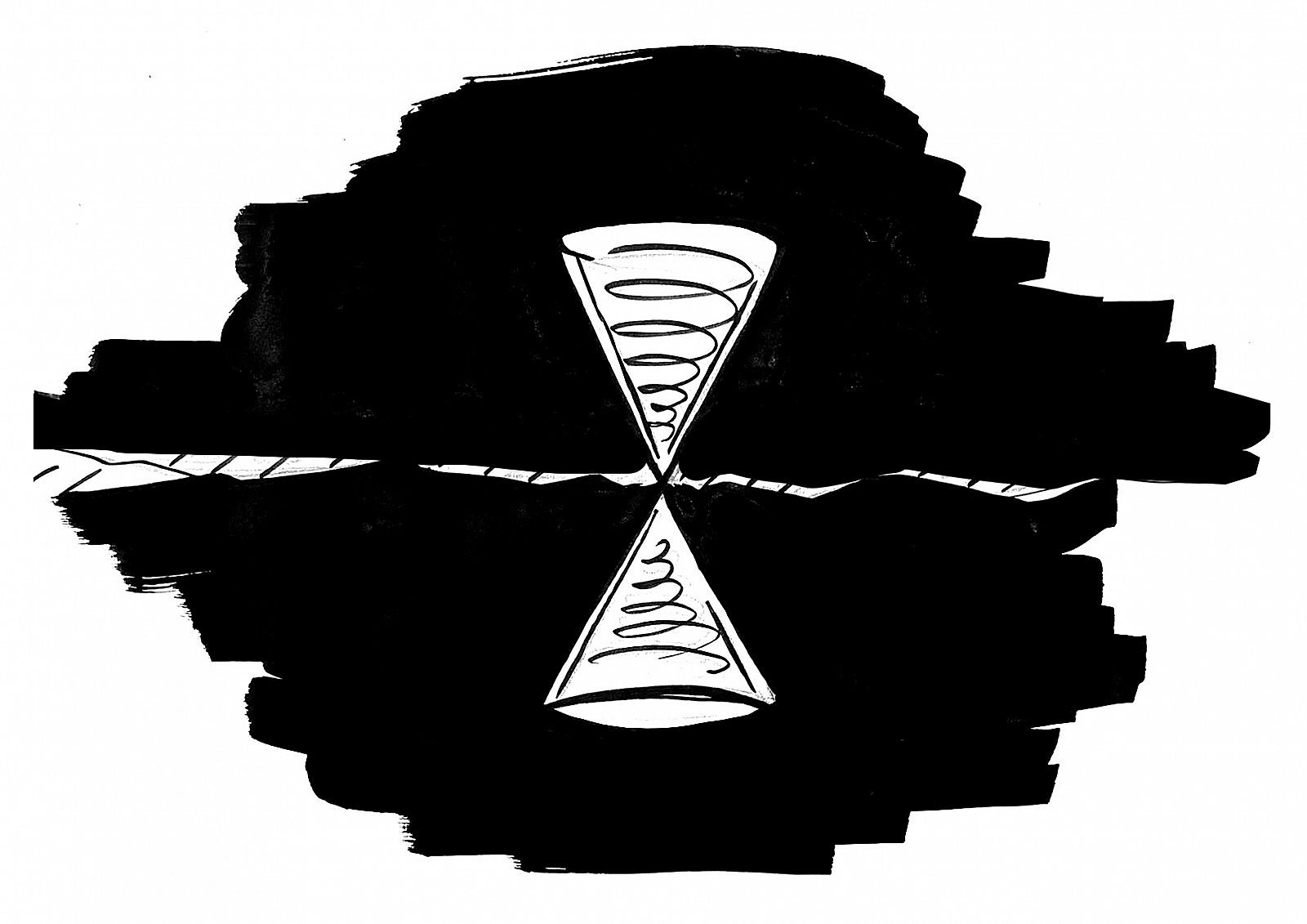This hourglass-shaped building in the desert can accommodate 170,000 people at a time. Its two cones, sitting above and below the ground, are the same volume. The façade of the building absorbs and refracts sunlight at will, making it convenient for natural mimicry. When we discovered this building, it had been completely concealed by the desert. Needless to say, it has a highly discreet entrance. Upon entering the cone, one is confronted by a row of clocks hanging on the wall behind the front desk, each presenting a different time. Every clock has its own system for calculating time, implying that, once inside this building, one must abandon the customary concept of time. In similar fashion, the lighting design of the building does not follow the laws of the sun.
Inside the inverted cone towering above the ground, a transparent running track spirals upward. One can gain a clear vision of people on the track from every floor of the building. The multi-layered design allows for sports like racing to be conducted from top to bottom or vice versa. In addition, the audience can elevate their sports viewing experience through a headset that analyzes the athletes’ movements in detail, as though one were contemplating sculptural masterpieces in a museum. A large circle of downspouts is assembled at the top of the cone. Water that drains from the building forms a whirlpool and is reserved for rituals—apparently, it is not fire that people worship here.
Down along the spiral track are corridors that lead to different areas of the building. In the middle section of the cone is an arena that doubles as a monument. Athletes climb up to a white cylindrical pedestal made of marble, which measures 30 meters in diameter and five meters in height, to fight their opponents off the platform. The entire battle is considered a time-based sculpture.
One can reach the second-to-last floor via the corridor. The post-ritual water accumulates here through the drainage system and becomes a small-scale waterfall. A series of colored reliefs hang on the wall, displaying both classic iconographies related to bathing and non-gendered symbols that indicate the sacredness of the current bathing ritual.
Past the bathing section is the very bottom level of the cone, which hosts a plaza-esque resting lounge, the largest flat area in the entire building. While the overall lighting is intentionally kept dim, spotlights of specific colors follow each person as they enter, as if pouring the glory of the baptismal bath onto them. Further inside are winners’ podiums of various heights, on which sit abstract and figurative sculptures, so softly lit so as to attract the curiosity of visitors. Athletes take all oaths at the intersection of the two cones. Just as the architectural structure enables water to flow through the hourglass, we suddenly realize that perhaps sound is the greatest athlete that this building has brought to the fore. One can hear the oath of sportsmanship loud and clear from anywhere, without the aid of any electronic device.
Translated from the Chinese by Sixing Xu.
Lu Pingyuan was born in 1984 in Zhejiang province, China. He lives and works in Shanghai. Lu Pingyuan‘s artworks involve a variety of media, including texts, installations, videos, paintings, and others. For a few years, Lu Pingyuan concentrated his practice on the writing of “stories” as a unique type of media for art creation. These short “stories” significantly broaden the artworks’ state of existence in the real world, extend the inherent spirit of art itself. His works have been exhibited extensively in both national and international museums and biennales.
Sixing Xu is an artist working with sculpture and text. She graduated from Vassar College and is currently based in Beijing.
平行奥运 Olympic Reveries
In tandem with the Tokyo Olympics, Heichi Magazine is hosting a parallel assembly of artist essays. Olympic Reveries emphasizes the cultural spaces opened up by sports and the illusion of spatiotemporal unity created by live broadcasts. We invited artists to extend the ideas of athleticism and national culture into their practices and speculate on real or imagined games that present values different from those of mainstream sporting events.
